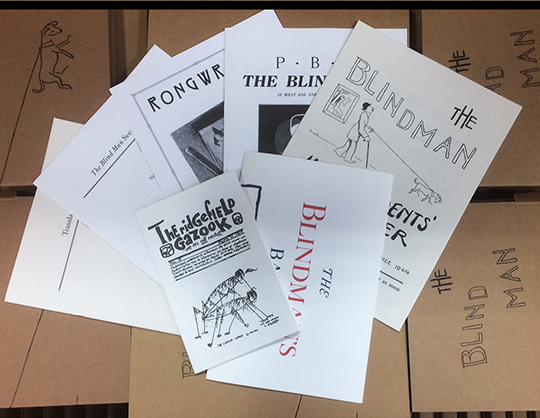The Blind Man: 100th Anniversary Facsimile Edition edited by Marcel Duchamp, Henri-Pierre Roché, and Beatrice Wood (Ugly Duckling Press, 2017). Translated from the French by Elizabeth Zuba.
With all of the uncertainties of the current geopolitical climate, it is fitting that in the beginning of 2018 we turn our attention to the past for historical context and a better sense of the wider context of recent events. In Sophie Seita’s insightful essay that accompanies Ugly Duckling Presse’s one hundredth anniversary facsimile collection of Dadaist zines and ephemera associated with The Blind Man (referred to in Hyperallergic as “a trove of Dadaist fun”), the critic encourages readers to understand Ugly Duckling’s reissue of these magazines precisely within their broader context, with “a facsimile reprint like ours attempt[ing] to recreate the original print context and…forg[ing] new dialogues with contemporary literary and artistic communities today.” Of course, in 1917, Europe was in the throes of World War I, and the artistic movement which the The Blind Man is most closely associated, Dada, is frequently held up as “an artistic revolt and protest against traditional beliefs of a pro-war society.” Rather than simply the considerable achievement of reproducing a one hundred-year-old, self-consciously cheeky avant-garde magazine in a beautiful collector’s edition, I’m keenly interested in the dialogues Seita claims the re-edition seeks to cultivate, meditating as much on what The Blind Man tells us about the present as it tells us about the past. In my view, Ugly Duckling more than delivers.
To take up but one example, the facsimile edition allows us to reexamine, again in Seita’s words, “how the history of Dada and Modernism has tended to occlude the work of female artists and writers, who are often remembered as wives or muses—or for interesting gossip—rather than for their own work.” Indeed, many readers are no doubt already intimate familiar with the so-called big names associated with the magazine and the social circles whirling around it, artists such as Marcel Duchamp and Man Ray, and come to the facsimile edition expecting to encounter magazines designed to further the careers of these male artists. In fact, nothing could be further from the case. The publications not only showcase the talent and wit of Beatrice Wood, Mina Loy, and Louise Arensberg, but, as Seita notes, the lion’s share of the column space in the second issue is given to female artists, poets, and critics. Coincidentally, this issue is where these women take up a rigorous and at times light-hearted defense of Duchamp’s infamous “Fountain” episode in which the artist submitted a urinal to a 1916 exhibition sponsored by the Society of Independent Artists under the pseudonym R. Mutt. The brilliant critical essays in defense of “Mutt’s” work, essays which have undoubtedly shaped a good deal of critical debate surrounding the piece in the last century, were authored by women, Wood and Louise Norton. Republishing these pieces in this format recognizes the importance of their contributions to these enduring critical and artistic dialogues, thereby giving even the most casual reader pause to reconsider how women’s vast intellectual contributions have been elided over the past century.
The facsimile edition itself is a well-designed, beautifully executed collector’s piece that makes use of a range of materials and printing practices. That is, beyond the words themselves, the textuality of the work does justice to the playfully serious attitude of the original. The edition arrives encased in a cardboard box designed to hold its contents which, in addition to facsimile editions of the two issues of The Blindman and Seita’s introduction, also include translations of French texts from the magazines by Elizabeth Zuba and assorted ephemerae such as a reproduction of Beatrice Wood’s poster for “The Blind Man’s Ball” (1917), Man Ray’s The Ridgefield Gazook (1915), and rongwrong, often considered The Blindman’s third and final issue. A note card accompanying these items details the processes and materials engaged in producing the edition, with a number of different plates, techniques, and papers that were used. The result is that the pictures and visual qualities of these texts jump off of the page. In doing so, they remind us that while the digital does indeed facilitate access to materials, the tangible qualities of physical objects continue to offer their own set of artistic possibilities. The subtle differences across these texts encourage the reader’s slow and careful perusal of the works, and underscore how reading is as physical as it is visual. For the quality of its execution, Ugly Duckling’s facsimile edition of The Blind Man is an amazing addition to its ongoing Lost Literature Series and a fitting homage to The Blind Man on its one hundredth anniversary. In fomenting dialogues that reconnect the past to the present, it not only makes one look forward to the next installment in the series, but also look back to see what one has already missed.
Paul Worley is Asymptote‘s Editor-at-Large for Mexico and a professor of English at Western Carolina University.
*****
Read more reviews here:

